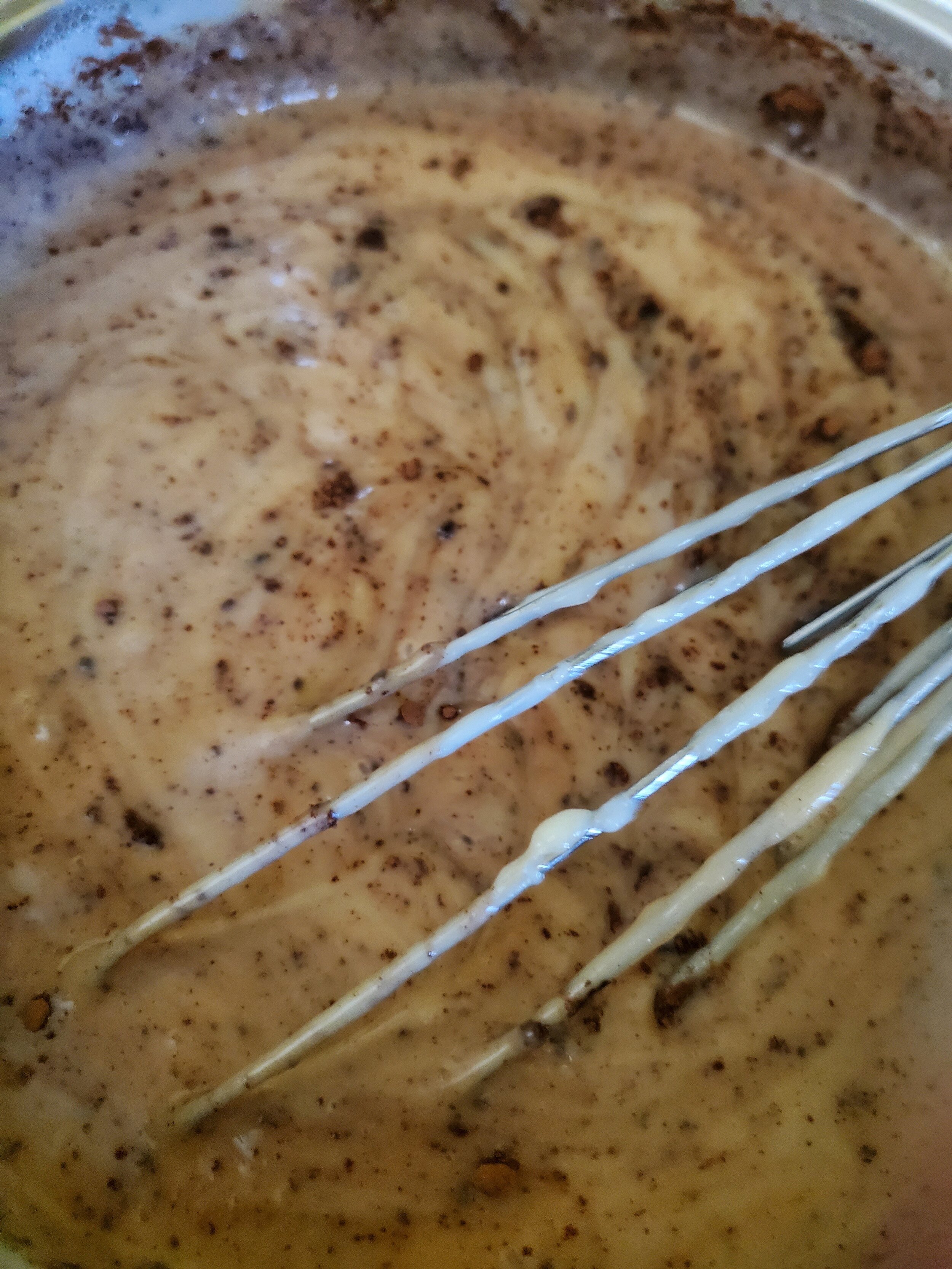For when you want more than just one candy.
We would really like to call this recipe something more specific, but that would risk running afoul of some copyright laws. We like to think our favorite candy manufacturer would give us a green light, but better safe than sorry. Imagine, if you will, a familiar orange wrapper with yellow letters and the fantastic peanut butter and chocolate treat it contains. And now you can see what we want to call this recipe, but cannot.
Chances are, if your imagination is strong enough (or your stomach empty enough), you can now also taste exactly what we were thinking of. Sorry. For what it's worth, this pudding is a pretty close approximation. And you probably don't even have to run to the store for anything! Phew - candy crisis avoided (narrowly).
You'll need a lot of milk, some peanut butter, some baker's chocolate, sugar, starch, butter, vanilla and a bit of chill time for this recipe. You'll only be actively working on it for five or ten minutes, because the fridge will do the rest for you - provided it's working, of course. If it isn't, please see our contact information at the bottom of this post.
Ingredients:
1/2 cup sugar
3 Tablespoons corn starch
1/4 teaspoon table salt
3 cups milk (full fat works best)
2 Tablespoons butter
2 Tablespoons baker's cocoa
3/4 cup peanut butter (we recommend smooth; crunchy is terribly difficult to whisk)
1 tablespoon vanilla extract
Tools:
Pan, whisk, fine sieve or sifter, measuring cups and spoons, heat-proof bowl that is also safe to move to the refrigerator (so, plastic, most likely), something to cover the bowl (a lid, foil, an overturned plate, etc.).
For starters, use a bigger pan than you think you need. Go for at least a two quart pan. We know, three cups of milk doesn't sound like a lot, and you're certainly not adding a whole lot of volume to it... But keep in mind that milk foams. Plus, you're going to be vigorously whisking this in a few steps. So to save yourself from having to scrub scalded milk off the stove later, just use a bigger pan. Trust us on this one.
Measure your milk, sugar, salt and starch into the pan. In order to avoid lumpy pudding, you may wish to sift the corn starch into the milk. It's optional, but we don't think anyone really wants lumps of starch in their pudding. When you're done, don't toss the sieve or sifter into the sink for a wash yet - you'll probably want it again later.
Turn the heat on under the pan and bring it up to medium. Your goal is to get the milk mixture to foam aggressively and begin to boil, but you don't want to allow it to scald (scalded milk is great for hot chocolate, but will negatively affect the taste of the pudding). Stir it frequently while you wait for it to come up to boil. If you see the foam around the edge pan starting to brown, lower the heat a notch. It'll take longer to come to boil, but you want uniformity, not speed here.
Once you have it up at a foamy boil, take the heat all the way down as low as it will go and whisk /constantly/ for a minute or two. Don't let it rest here. You can stop whisking when you see the whisk leaving tracks in the foam that take more than three seconds to fill back in. If you get past the two minute mark whisking constantly, and you still don't have a visible track from the whisk when you slow down, turn the heat back up, simmer it another minute, and then try again. This step is a big deal for getting the pudding to set later, so please don't be tempted to cut a corner. If you're really, really struggling, you can add another half teaspoon of corn starch - but stop at half a teaspoon!
After you've achieved the ideal texture, pour or sift in the baker's cocoa. This is why we mentioned that you might not want to put the sieve up for a wash yet - cocoa tends to form little lumps. (We kind of like the cocoa lumps, though, so we leave them alone. Not sifting makes it look a little like the cookie bits in cookies and cream ice cream.)
Once the cocoa has been mixed in, turn the heat completely off. Drop in the peanut butter, butter and vanilla extract. Whisk until it's all thoroughly incorporated.
Whisking room temperature peanut butter is no easy task. If you'd like, you can melt it in the microwave before pouring it into the milk. That will make it easier to stir, but you have to be extra careful to heat it only just barely enough in the microwave. Melting is the goal, but even a few seconds too long on high can burn the edges and make them solidify. Solidified, scorched peanut butter will not make tasty pudding (although it's actually pretty good as an ice cream topping, believe it or not. Also, we clearly have ice cream on the brain today).
Once you've reached the point where it's all one color and you're no longer turning up hidden pockets of peanut butter, you're good to put it into that heat-proof bowl (or perhaps portion containers), cover it with plastic wrap, foil or a lid, and tuck it safely into the fridge to chill. It will take a couple hours to set up completely, but once it does, you have dessert ready to go.
We know your kitchen is going to be full of the smell of peanut-buttery goodness, but the wait is worth it. Go do something while the timer counts down. Maybe you could let us know over on Facebook what you thought of this recipe. When the timer has gone off and you’ve dished up the pudding, you can top it with a couple of different things. We like keeping it simple, a little bit of whipped cream and some chocolate syrup is all this needs for us. For kiddos, you might add some sprinkles though, or you could add in some fruit preserves. We’ve heard that strawberry or grape make a good addition. You can even use the pudding as layers for a trifle if you want to get really fancy.
Remember up top how we mentioned your fridge not working? Heaven forbid that’s the case not that it’s officially summer, but if so, we can help. We’ve got the knowledge and skill to fix all of your major appliances, from your trust refrigerator to your dryer and anything in between. Just give us a call at ((214) 599-0055) or set up an appointment on our website. We want to help keep your home running smoothly, even when the heat is driving the world crazy.
Some other articles we think you might like.
Double Chocolate Guinness Cupcakes
Easy As 1-2-3 Christmas Cookies








